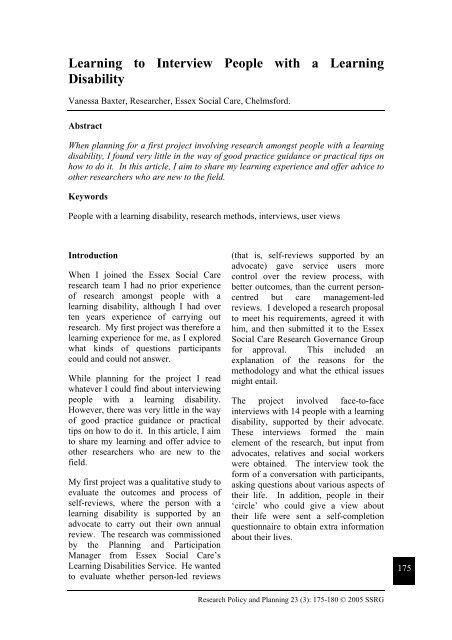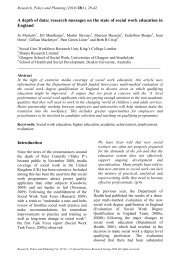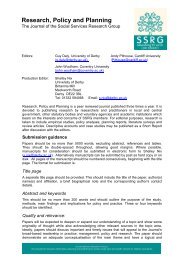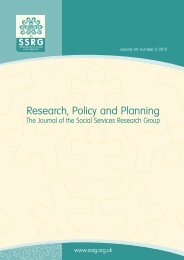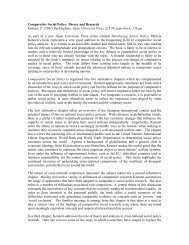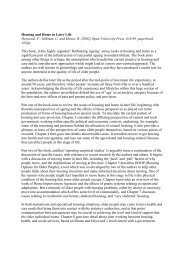Short report: Learning to Interview People with a Learning Disability
Short report: Learning to Interview People with a Learning Disability
Short report: Learning to Interview People with a Learning Disability
You also want an ePaper? Increase the reach of your titles
YUMPU automatically turns print PDFs into web optimized ePapers that Google loves.
<strong>Learning</strong> <strong>to</strong> <strong>Interview</strong> <strong>People</strong> <strong>with</strong> a <strong>Learning</strong><strong>Disability</strong>Vanessa Baxter, Researcher, Essex Social Care, Chelmsford.AbstractWhen planning for a first project involving research amongst people <strong>with</strong> a learningdisability, I found very little in the way of good practice guidance or practical tips onhow <strong>to</strong> do it. In this article, I aim <strong>to</strong> share my learning experience and offer advice <strong>to</strong>other researchers who are new <strong>to</strong> the field.Keywords<strong>People</strong> <strong>with</strong> a learning disability, research methods, interviews, user viewsIntroductionWhen I joined the Essex Social Careresearch team I had no prior experienceof research amongst people <strong>with</strong> alearning disability, although I had overten years experience of carrying outresearch. My first project was therefore alearning experience for me, as I exploredwhat kinds of questions participantscould and could not answer.While planning for the project I readwhatever I could find about interviewingpeople <strong>with</strong> a learning disability.However, there was very little in the wayof good practice guidance or practicaltips on how <strong>to</strong> do it. In this article, I aim<strong>to</strong> share my learning and offer advice <strong>to</strong>other researchers who are new <strong>to</strong> thefield.My first project was a qualitative study <strong>to</strong>evaluate the outcomes and process ofself-reviews, where the person <strong>with</strong> alearning disability is supported by anadvocate <strong>to</strong> carry out their own annualreview. The research was commissionedby the Planning and ParticipationManager from Essex Social Care’s<strong>Learning</strong> Disabilities Service. He wanted<strong>to</strong> evaluate whether person-led reviews(that is, self-reviews supported by anadvocate) gave service users morecontrol over the review process, <strong>with</strong>better outcomes, than the current personcentredbut care management-ledreviews. I developed a research proposal<strong>to</strong> meet his requirements, agreed it <strong>with</strong>him, and then submitted it <strong>to</strong> the EssexSocial Care Research Governance Groupfor approval. This included anexplanation of the reasons for themethodology and what the ethical issuesmight entail.The project involved face-<strong>to</strong>-faceinterviews <strong>with</strong> 14 people <strong>with</strong> a learningdisability, supported by their advocate.These interviews formed the mainelement of the research, but input fromadvocates, relatives and social workerswere obtained. The interview <strong>to</strong>ok theform of a conversation <strong>with</strong> participants,asking questions about various aspects oftheir life. In addition, people in their‘circle’ who could give a view abouttheir life were sent a self-completionquestionnaire <strong>to</strong> obtain extra informationabout their lives.175Research Policy and Planning 23 (3): 175-180 © 2005 SSRG
Research Policy and Planning 23 (3)176<strong>Interview</strong>ingFormat of interviewsThe advocates worked <strong>with</strong> each personin advance <strong>to</strong> prepare him or her for theirself-review. Most of the researchinterviews were carried out after the preplanningstage and before the review.However, I learnt that it was necessary <strong>to</strong>be flexible about this and adapt <strong>to</strong> eachindividual’s circumstances, so that fourresearch interviews <strong>to</strong>ok place <strong>with</strong>in thereview meeting itself. This meant tha<strong>to</strong>thers present, such as parents andsupport workers, could give their viewsabout the person’s life: this was essentialfor the two people who had no verbalcommunication.This article deals mainly <strong>with</strong> myexperience of interviewing the 12 peoplewho did have a level of verbalcommunication ability. I collectedinformation about the lives of the twopeople <strong>with</strong> no verbal skills from parents,advocates and support workers whoknew them well. This was the mostpractical way of gaining data about theirlives, as I did not have the time orresources <strong>to</strong> develop a way ofcommunicating <strong>with</strong> them. There wassome evidence <strong>to</strong> suggest that the twopeople followed at least some of thediscussion during the interview, and theyat least unders<strong>to</strong>od that it was aboutthem.<strong>Interview</strong> arrangements and consentThe advocates had explained about theresearch and asked the participants <strong>to</strong>sign a simple consent form before I metthem. They also arranged the time andvenue, which was mostly someone’shome or day centre, depending on wherethe person would feel most at ease. Thefact that the advocates set up myinterview <strong>with</strong> each person was a greathelp and saved me a lot of time. It meantI did not have <strong>to</strong> identify and recruit alink person for each of the 14 participants<strong>to</strong> explain about the research, gainconsent, and arrange for me <strong>to</strong> meet <strong>with</strong>them. It also made it very easy for me <strong>to</strong>arrive and start asking questions, as thepeople were expecting me and weremeeting me <strong>with</strong> their advocate, whoknew them well. Each interview began<strong>with</strong> a cup of tea or coffee (often madeby the participant) and some generalchat, which helped <strong>to</strong> break the ice beforethe interview as such started.Although the advocates had previouslyexplained why I was coming <strong>to</strong> talk <strong>to</strong>them, it was clear that participants didnot really understand what the researchprocess is, and what I would be doing<strong>with</strong> their replies, but were merely happy<strong>to</strong> answer my questions and tell me abouttheir lives. A developmental area for me,which is something that I have done insubsequent projects, has been <strong>to</strong> producean information sheet for the service userusing simple words and symbols. Thisexplains who I am, why I am askingthem questions and what I will do <strong>with</strong>what they tell me. It also covers the factthat what they say will be keptconfidential (unless they say someone ishurting them) and that the services theyreceive will not be affected. It has mypho<strong>to</strong> on it and gives details of how <strong>to</strong>contact me. I have found it useful <strong>to</strong> gothrough this sheet <strong>with</strong> the person at thebeginning of each interview, as it helps <strong>to</strong>reinforce why I am there and that theirinput is valuable.Going through the information sheet alsohelps me <strong>to</strong> be more certain that peopleare in fact consenting <strong>to</strong> the interview.While they may not necessarilyunderstand what research is, they must beable <strong>to</strong> choose whether they wish <strong>to</strong> talk<strong>to</strong> me and answer my questions.However, during the interview it’simportant <strong>to</strong> consider verbal signals <strong>to</strong>make sure that the person is still happy <strong>to</strong>continue <strong>with</strong> the interview and does notwish <strong>to</strong> <strong>with</strong>draw.
Baxter: <strong>Learning</strong> <strong>to</strong> interview people <strong>with</strong> a learning disability<strong>Interview</strong> contentThe interviews were designed <strong>to</strong> be aconversation about people’s lives, <strong>with</strong>question prompts <strong>to</strong> elicit keyinformation. These were themed aroundquality of life elements, such as housing,daytime activities, education,employment, leisure activities, money,and transport. To keep the conversationflowing, I did not write down whatpeople said but tape recorded theinterview and recorded answers later.Only one person was unhappy about merecording their interview and refusedconsent.In order <strong>to</strong> establish people’s priorities Ishowed a picture card for each aspect oftheir life and asked them <strong>to</strong> say whichwere important <strong>to</strong> them and which werenot. However, almost all the cards wereput in<strong>to</strong> the important pile and no onesaid that more than two aspects were notimportant <strong>to</strong> them. Even when a cardwas judged unimportant initially, manypeople later went on <strong>to</strong> talk about issues<strong>with</strong>in that aspect, so had <strong>to</strong> move it <strong>to</strong>the important category. Almost all of theparticipants found it difficult <strong>to</strong>distinguish whether the aspects were veryimportant <strong>to</strong> them or just important.Responses <strong>to</strong> questionsI found that if I asked questions <strong>with</strong> a‘yes/no’ answer, I had <strong>to</strong> probe theresponse given, for example, ‘why doyou say that?’ or ‘can you give me anexample?’ since many respondents didnot elaborate spontaneously. With somepeople, I also felt that they perhapswanted <strong>to</strong> agree <strong>with</strong> me or give ananswer that would please someone elsepresent (especially if a family carer orsupport worker was listening).During the interview, participants oftencontradicted something that they had saidearlier, which meant going back <strong>to</strong> thespecific question <strong>to</strong> test which one wasthe correct answer. Also, someparticipants appeared very suggestible,agreeing <strong>with</strong> whatever was asked, sothat I needed <strong>to</strong> probe <strong>to</strong> try <strong>to</strong> ascertaintheir actual feelings. This was one areawhere I found it helpful <strong>to</strong> have theadvocate present, as they could challengea response based on what they knew ofthe person or the prepara<strong>to</strong>ry work done.The advocates’ role during the interviewswas <strong>to</strong> introduce me and what I wasdoing and then support the person inanswering questions but not answer thequestions on the person’s behalf. Thisworked well and advocates onlycontributed if they thought the personhad not unders<strong>to</strong>od the question fully orthey needed <strong>to</strong> explain an answer <strong>to</strong> me.Advocates were usually able <strong>to</strong> explainquestions in terms participants couldrelate <strong>to</strong> (for example, talking about aspecific person’s name rather than a jobtitle) due <strong>to</strong> their knowledge of theperson and their life. This kind of nonoverpoweringcontribution may beunique <strong>to</strong> advocates since it is their role<strong>to</strong> support a person <strong>to</strong> speak up. I havefound in subsequent projects thatsometimes family carers and supportstaff can overpower or speak on behalf ofthe person <strong>with</strong> a learning disability,which may be contrary <strong>to</strong> what theperson would say if on his or her own.I asked each person how happy he or shewas <strong>with</strong> each aspect of their life, at theend of the questions relating <strong>to</strong> that area.I had brought along a card <strong>with</strong> fourfaces on it, representing replies rangingfrom ‘very happy’ <strong>to</strong> ‘not at all happy’.The person could indicate which facebest described how they felt, either bypointing <strong>to</strong> it or telling me. I found thisworked well in helping the participants <strong>to</strong>give a reply: a few of them were able <strong>to</strong>use the word scale, but most seemed <strong>to</strong>respond best <strong>to</strong> the pictures’ expressions.177
Research Policy and Planning 23 (3)178Challenges <strong>to</strong> asking questions aboutchoice and controlThe people interviewed found it verydifficult <strong>to</strong> answer questions about whatthey would like <strong>to</strong> see change in theirlives. This seems <strong>to</strong> be because theyrelate mostly <strong>to</strong> personal experience andwere unable <strong>to</strong> think of an activity thatthey had not previously tried. Only oneperson gave any meaningful answer <strong>to</strong>the question that came <strong>to</strong>wards the end ofthe interview: ‘What one thing aboutyour life would you like <strong>to</strong> change?’Most respondents clearly could not thinkin this way or give an answer: whenprompted about things they hadmentioned earlier in the interview someagreed <strong>with</strong> the prompt. Wider picturedata was also difficult <strong>to</strong> extract, asalmost all the participants broughtgeneral questions back <strong>to</strong> theirindividual, small-scale concerns.In general, people struggled <strong>to</strong>understand what was meant by having achoice in their lives, <strong>with</strong> most requiringan explanation <strong>with</strong> concrete examples,such as choosing what <strong>to</strong> wear or what <strong>to</strong>have for breakfast. The only two peoplewho were able <strong>to</strong> answer a questionabout how much choice they have intheir everyday lives said that they have alot of choice. However, the people inparticipants’ ‘circles’ were divided fairlyequally between those who felt that theyhad a lot of choice, quite a lot of choice,some choice or not very much choice.Only one family carer felt that theirrelative had no choice at all.Most participants seemed hesitant whenasked about how much control they hadover their lives, <strong>with</strong> less confidence inthemselves than others who know them.When asked who they feel is in charge,seven people said that the staff/carer wasin charge and just three felt that theywere. Family carers when asked thisquestion were more inclined <strong>to</strong> say thatdecisions were made jointly between theperson and staff.Length of interviewsMy experience was that the length of theinterview (the average was just over anhour long) was hardest for the people<strong>with</strong> a lower level of understanding orcommunication skills. Several peopleclearly found it difficult <strong>to</strong> concentrateafter about an hour or so: sometimeshaving a break in the middle was useful<strong>to</strong> res<strong>to</strong>re concentration, although wherethis was the case I found that there waslittle point continuing for more thananother half an hour. One person wasworried about when her support workerwas going <strong>to</strong> arrive <strong>to</strong> take her in<strong>to</strong> <strong>to</strong>wn<strong>to</strong> get her holiday money so that thisinterview was interrupted several timeswhen the advocate needed <strong>to</strong> reassure herthat everything was alright. It wastherefore difficult <strong>to</strong> get this person <strong>to</strong>concentrate fully on my questions forvery long at a time.DiscussionHints and tips when planning researchBased upon my experiences, I havedrawn up a checklist for researchers,practitioners and policymakers who arehoping <strong>to</strong> include people <strong>with</strong> a learningdisability in planning or evaluatingservices or in undertaking research.• Decide whether you are going <strong>to</strong>include people <strong>with</strong> either limitedor no communication skills/understanding in your sample. Ifso, can you collect views/perceptions about them fromsomeone who knows them well?• Always try <strong>to</strong> gather informationusing the face-<strong>to</strong>-face approach.Many people <strong>with</strong> a learningdisability will be unable <strong>to</strong> read aquestionnaire, even if symbols areused, and will have difficulty in
Baxter: <strong>Learning</strong> <strong>to</strong> interview people <strong>with</strong> a learning disabilityunderstanding how <strong>to</strong> fill one in.They may also worry abouthaving <strong>to</strong> fill in an ‘official form’.Most would have <strong>to</strong> ask someonefor help <strong>to</strong> complete a writtenquestionnaire, in which case youwould not know whose opinionsare provided - the person him orherself or what the helper thinksthey might say.• Although the person <strong>with</strong> alearning disability has <strong>to</strong> consent<strong>to</strong> the interview, it is courtesy <strong>to</strong>inform others in their immediatecircle about the research. Thiscan help <strong>to</strong> gain the person’sconsent and smooth the way <strong>to</strong>arranging the interview.• Identify someone who canintroduce you and the research <strong>to</strong>the participant: you cannot ‘coldcall’ people <strong>with</strong> a learningdisability. Ask if the person willneed a supporter in the interviewand if so who? If a supporter ispresent, check that the person ishappy <strong>to</strong> have them there and laydown some ground rules, forexample, that they are there <strong>to</strong>help the person answer thequestions and not provideanswers for them.• Produce a simple and accessibleinformation sheet explaining whatthe research is about, how itinvolves the person and details ofhow <strong>to</strong> contact the researcher. Gothrough this at the start of eachinterview and check the person’sunderstanding before they signthe (simply worded) consentform.• Try and hold the interview in aplace that the participant knowsand where they are comfortable.Spend a little time at the start ofthe interview <strong>to</strong> chat <strong>to</strong> the personand break the ice. It can take awhile for them <strong>to</strong> get used <strong>to</strong> yourpresence and open up <strong>to</strong>questions. Explain that theirreplies will be kept confidentialand anonymous.• Keep interviews short. Have abreak if the participant seems <strong>to</strong>be losing concentration. End theinterview if the participant seems<strong>to</strong> be getting distressed or saysthat they would like <strong>to</strong> s<strong>to</strong>p.• Keep your questions simple andbe prepared <strong>to</strong> probe theresponses given. Avoid questions<strong>with</strong> yes/no answers, but whereyou include one of these types ofquestions then ask the participant<strong>to</strong> explain why they say that. If asupporter is present who knowsthe person well, they may be able<strong>to</strong> help you <strong>to</strong> understand whatthe participant actually means.• Be aware that many people <strong>with</strong> alearning disability relate best <strong>to</strong>things they have experienced intheir own lives. It is thereforedifficult <strong>to</strong> ask them how theyfeel about something that is newor different <strong>to</strong> what they know, orget them <strong>to</strong> think creatively.• Many people <strong>with</strong> a learningdisability are eager <strong>to</strong> please, sobe careful not <strong>to</strong> prompt them<strong>with</strong> a suggestion or they may justagree <strong>with</strong> what you have said.• If you are using scales, keep themvery simple <strong>with</strong> no more thanfour points and prepare somesymbols (for example, happy/sadfaces) <strong>to</strong> represent each point onthe scale. Some participants willrespond better <strong>to</strong> pictures thanwords.• Pictures or symbols can help <strong>to</strong>engage the participant’s interestand help them visualise the179
Research Policy and Planning 23 (3)<strong>to</strong>pics. This technique is alsoused when interviewing children.Notes on contribu<strong>to</strong>rVanessa Baxter worked for a majorengineering company for ten years,carrying out a variety of qualitative andquantitative research projects. Thisincluded researching cus<strong>to</strong>mersatisfaction, brand values, market sizeand share. She then worked in thecommunications team for Essex SocialCare for over four years, before joiningthe Essex Social Care Research Team inAugust 2003. She passed the MarketResearch Society Diploma in 1996 and isa full member of the Market ResearchSociety.Address for correspondenceVanessa BaxterResearcherEssex Social CareCounty HallPO Box 297ChelmsfordCM1 1YSTelephone: 01245 434667.Email: vanessa.baxter@essexcc.gov.uk.180


